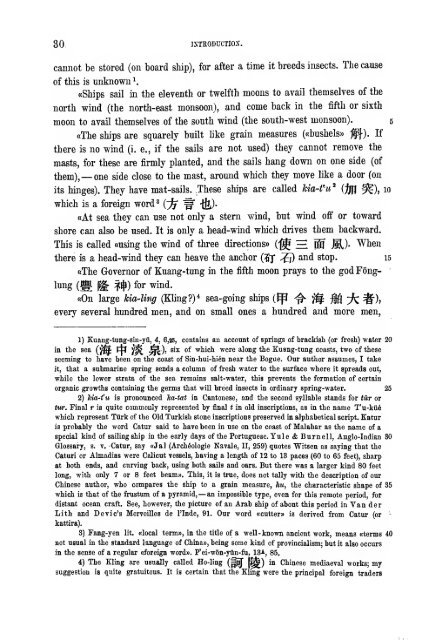Chau Ju-Kua - University of Oregon Libraries
Chau Ju-Kua - University of Oregon Libraries
Chau Ju-Kua - University of Oregon Libraries
Create successful ePaper yourself
Turn your PDF publications into a flip-book with our unique Google optimized e-Paper software.
30<br />
ISTKODrCTIOX.<br />
cannot be stored (on board ship), for after a time it breeds insects. Tlie cause<br />
<strong>of</strong> this is unknown ^<br />
«Ships sail in the eleventh or twelfth moons to avail themselves <strong>of</strong> the<br />
north wind (the north-east monsoon), and come back in the fifth or sixth<br />
moon to avail themselves <strong>of</strong> the south wind (the south-west monsoon). 5<br />
((The ships are squarely built like grain measures (((bushels» %^). If<br />
there is no wind (i. e., if the sails are not used) they cannot remove the<br />
masts, for these are firmly planted, and the sails hang down on one side (<strong>of</strong><br />
them),—one side close to the mast, around which they move like a door (on<br />
its hinges). They have mat-sails. .These ships are called kia-t'u^ (jjlfl ^), 10<br />
which is a foreign word^ (^ "^ -j;^).<br />
((At sea they can use not only a stern wind, but wind <strong>of</strong>f or toward<br />
shore can also be used. It is only a head-wind which drives them backward.<br />
This is called «using the wind <strong>of</strong> three directions)) {-^ ^ ^ ^). When<br />
there is a head-wind they can heave the anchor (|J J^) and stop. 15<br />
((The Governor <strong>of</strong> <strong>Kua</strong>ng-tung in the fifth moon prays to the god Fong-<br />
lung (^ 1^ ^^) for wind.<br />
((On large kia-Ung (Kling?)* sea-going ships (^ ^ "M M ik ^)><br />
every several hundred men, and on small ones a hundred and more men,<br />
1) <strong>Kua</strong>ng-tung-sin-yfl, 4, 6,a5, contains an account <strong>of</strong> springs <strong>of</strong> brackish (or fresh) water 20<br />
in the sea ("^ ptl V^ ^^)' ^^^ "^ which were along the <strong>Kua</strong>ng-tung coasts, two <strong>of</strong> these<br />
seeming to have been on the coast <strong>of</strong> Sin-hui-hien near the Bogae. Our author assumes, I take<br />
it, that a submarine spring sends a column <strong>of</strong> fresh water to the surface where it spreads out,<br />
while the lower strata <strong>of</strong> the sea remains salt-water, this prevents the formation <strong>of</strong> certain<br />
organic growths containing the germs that will breed insects in ordinary spring-water. 25<br />
2) Icia-t'u is pronounced Jca-tat in Cantonese, and the second syllable stands for tur or<br />
tur. Final r is quite commonly represented by final t in old inscriptions, as in the name T'u-ku6<br />
which represent Ttlrk <strong>of</strong> the Old Turkish stone inscriptions preserved in alphabetical script. Katur<br />
is proba.hly the word Catur said to have been in use on the coast <strong>of</strong> Malabar as the name <strong>of</strong> a<br />
special kind <strong>of</strong> sailing ship in the early days <strong>of</strong> the Portuguese. Yule & Burnell, Anglo-Indian 30<br />
Glossary, s. v. -Catur, say «Jal (Archfiologie Navale, II, 259) quotes Witsen as saying that the<br />
Caturi or Almadias were Calicut vessels, having a length <strong>of</strong> 12 to 13 paces (60 to 65 feet), sharp<br />
at both ends, and curving back, using both sails and oars. But there was a larger kind 80 feet<br />
long, with only 7 or 8 feet beam». This, it is true, does not tally with the description <strong>of</strong> our<br />
Chinese author, who compares the ship to a grain measure, hu, the characteristic shape <strong>of</strong> 35<br />
which is that <strong>of</strong> the frustum <strong>of</strong> a pyramid,—an impossible type, even for this remote period, for<br />
distant ocean craft. See, however, the picture <strong>of</strong> an Arab ship <strong>of</strong> about this period in Van der<br />
Lith and Devic's Merveilles de I'Inde, 91. Our word «cutter» is derived from Catur (or<br />
kattira).<br />
3) Fang-yen lit. «local terms, in the title <strong>of</strong> a well-known ancient work, means «terms 40<br />
not usual in the standard language <strong>of</strong> China)), being some kind <strong>of</strong> provincialism; but it also occurs<br />
in the sense <strong>of</strong> a regular ((foreign word)). P'ei-w5n-yiin-fu, 13A, 85.<br />
4) The Kling are usually called Ho-ling (g^ |^) in Chinese mediaeval works; my<br />
suggestion is quite gratuitous. It is certain that the Kling were the principal foreign traders<br />
'

















